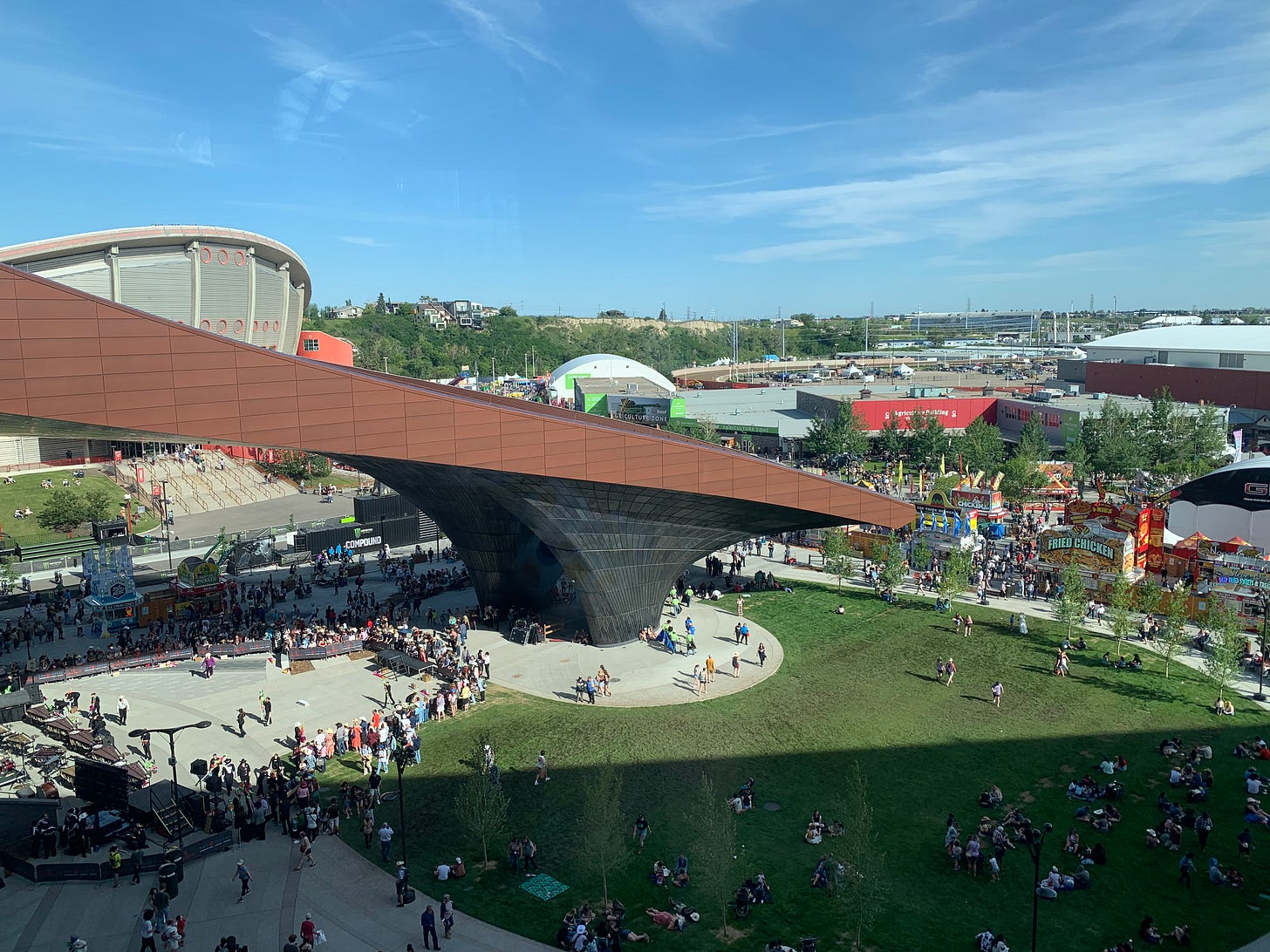Over the last decade, public investment in iconic architecture has produced impressive results in Calgary.
It all began with the National Music Centre (Allied Works, 2016): a monument to Canada’s prolific music scene; followed by the Central Library (Snøhetta, 2019): a monument to knowledge; and Platform (5468796 Architecture, 2022): a monument to cars and tech entrepreneurship — at least for now.
The latest addition to this list is BMO Centre’s expansion (Populous, 2024): a monument to… what exactly?
I can think of few other building typologies, beyond convention centres, able to express so effortlessly capitalism’s attempt to be “of the people,” while also excluding most.
In this regard, BMO Centre’s expansion does an outstanding job.
The architects at Kansas-City-based Populous, and Calgary’s O2 Design, the project’s landscape architects, effectively collaborated to create an inviting public realm that’s reflective of our city’s unique culture.
The generous amount of seating and native vegetation surrounding the whale-shaped building conceal the fact that this is not a public space. BMO Centre is private property, under surveillance 24/7, as not-so-subtle signs inform passersby.
The intricate shape of the building itself acts as a frame through which views of significance to many Calgarians come into focus: the Saddledome, the Big Four building, the prairie city’s ever-changing skyline — and, of course, BMO Centre itself.
The first time I set foot in the new building was during Stampede. At this time, the charade seemed less obvious, as most people seem to be welcome to join in the festivities — anyone in Calgary can be a cowboy for 10 days of the year.
BMO Centre was bustling, inside and out. An oasis of sorts in the midst of more-or-less organized chaos.
Outside, people enjoyed the shade below the venue’s 170-foot curved canopy, whose underbelly is speckled with LED lights. Inside, Stampede-goers took a break from the scorching heat, used a real washroom, or purchased a souvenir at the venue’s market.
Meanwhile, others took the vertigo-inducing escalators (which i would prefer not to use ever again in my lifetime) to get to the many events taking place within the building, including the Stampede President’s reception for Calgary’s VIPs, held in an outdoor terrace overlooking the commoners festivities below, and a wine showcase for the well-off in the 50,000-square-foot Champions Ballroom, where guests enjoyed an expansive view of the Stampede grounds in its full splendour.
Yet, despite the undeniable vibrancy, something made me uneasy — besides the steep escalator, that is.
While it’s obvious that no detail was spared in the meticulously designed facility, and there’s no question that the $500 million in public funding granted by all three levels of government to the Calgary Stampede, the building's owner, was put to good use, returning to the building on an unseasonably warm October day uncovered the true nature of the venue’s purpose.
During my recent visit, the only people using the promenade was a group of corporate-types that stood by the Spirit of Water, the plaza’s sculptural centre piece created by British artist Gerry Judah, likely strays from the LRT station’s official reopening earlier that morning.
Except for me walking around, and a crew of workers fixing a broken LED display screen, there were few others.
Not a single soul sat in one of the many picnic tables to eat their lunch, read a book, or even scroll on their phone, despite it being a gorgeous afternoon.
When I finally stepped inside the 1-million-square-foot convention centre, the largest in Western Canada, the oppressive atmosphere created by the scale of the interior massing — a necessary evil in a venue meant to hold events for up to 33,000 people at the same time — was inescapable.
BMO Centre feels a lot like an airport. And like an airport, the venue is mostly devoid of character, of a sense of place. The only clues to where on Earth you are — except for the panoramic views into the Stampede grounds, and the city behind it — are the Western-inspired artworks that tastefully adorn most walls.
But placelessness is part of the point.
As convention centres compete against each other for a spot in the global event circuit, buildings can’t be too unique, or make too much of a statement. The comfort of conference delegates is to be maintained at all times. (Like food at an all-inclusive resort, nothing can be too overpowering, bland appeals to most tastes.)
This doesn’t mean there’s anything sloppy about the venue, though.
The attention to detail paid by the design team only highlights the stark disparities that exist in Calgary, Canada’s second most unequal city in terms of income.
Not too far from the expanded BMO Centre, sits the Alpha House, an underfunded shelter and detox facility that serves unhoused Calgarians.
The feeling of unease I experienced during my first visit in July wasn’t the steep escalator, it was the blatant display of wealth in the face of deprivation.
Why can’t the rest of us enjoy that degree of thoughtfulness, of investment in our built environment?
Why do lower income folks have to accept windowless bedrooms when we obviously can do much, much better?
The Central Library remains the sole building that tells Calgarians, regardless of our background, that we’re worth the effort. (Except for public parks, i should note, but i’ll leave that for another time.)
I’m sure many flaws will come to light as the building ages, but for now, BMO Centre is a stark symbol of the chasm that exists between Calgary’s haves and the rest of us.
Reluctantly yours,
Ximena
Stuff i’ve written recently
When Public Pools Close, Who Loses Out?
The Tyee
A Home for Calgary’s One Percent
The Globe and Mail
Alberta Reserve 3D Prints Transitional Housing Development
Azure








A great read Ximena. Yes, all people deserve windows, and a home that invokes pride.